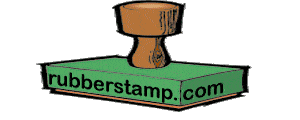Rubber Stamps 101
Rubber Stamps
When someone refers to a “regular stamp” they are usually talking about the kind of rubber stamp that requires a stamp pad. These kinds of stamps can be made out of several types of material depending on the kind of work the stamps will be used for.
The majority of stamp manufacturers use a photo-polymer to make custom stamps. Polymer is good for regular office stamping and works good in self-inking stamps. Polymer stamps cannot be used with corrosive or permanent inks. Corrosive or permanent ink formulas require stamps made with real rubber. For people who use rubber stamps for creating artwork, those are made from real rubber. They are very durable and holdup to stamping and washing for years if properly cared for.
Self-inking stamps are a self-contained unit housing the stamp and a small stamp pad. Each time you push down on the handle the stamp separates from the pad, rotates around and makes an impression. There are many manufacturers of self-inking mounts.
Pre-inked stamps are different from the self-inking stamps in that there are no moving parts. The stamp is made from a micro-porous material that keeps the ink in the stamp until pressure is applied. There are several types of mounts, processes for putting the ink into the porous material and many manufacturers of mounts.
Check out our self-inking and pre-ink page for more information about how they work and how to pick a good one.
Inks
There are hundreds of colors, types and formulas for inks. Most stamping products can use a few types of ink, including regular stamp ink used for paper stamping. Most of the time, regular ink is sufficient. There are, however, permanent inks for stamping on photos, glossy material, metal, plastic, pvc, and circuit boards. Most of these inks are available in slow or fast dry formulation, depending on how quickly the object needs to be handled after the impression is made.
Other ink formulations include invisible ink (this variety is visible with black light), food ink, FDA-approved inks, acid free(for archival purposes and scrapbooks), and many others depending on your needs.
When using different types of ink be sure to get the correct stamp pad for the ink. There are foam, felt, micropore, double-sided and stone stamp pads. Check with your stamp professional about which is the right pad for your uses. Remember: do not mix different types of ink in one stamp pad; this causes weird and occasionally nasty effects with your pads and stamps. When your stamp or pad starts to disfigure and warp, something might be wrong and it’s time to start over.
Be sure to talk through the purpose of your stamping and the materials to be stamped with your Stamp Professional. They can guide you to an “out-stamping” experience!
stamp/ink chart
Unless noted, we are referring to regular ink, or ink supplied with stamp(SI or Pre-inked).
Stamping onto glossy or slick paper can be done with regular inks if an embossing technique is used.
Remember, excellent stamping takes technique and practice.
|
Stamp Type:
|
polymer | real rubber | self-inking | pre-inked |
| Material: | ||||
| bond paper | Yes | Yes | Yes | Yes |
| glossy stock | perm. ink | try first | ||
| photos | perm. ink | try first | ||
| plastic | perm. ink | try first | ||
| Quality: | ||||
| rapid printing | hand stamp | hand stamp | Yes | [* see note below] |
| quality impression? | Yes | Yes | Yes | Yes |
| Graphics | Good | Good / Excellent | Good | Good |
[* After a few impressions, image will get lighter. You’ll need to let the stamp sit for the ink to redistribute.]
